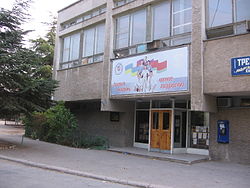- Sports school
-
For other uses, see Sports school (disambiguation).
 Sports school in Sevastopol
Sports school in Sevastopol
Sports school (Russian: Детско-Юношеская Спортивная Школа, ДЮСШ) is a type of educational institution for children that originated in the Soviet Union. Sports schools were the basis of the powerful system of physical culture (fitness) and sports education of the USSR. The main features of this system remain in the system of sports education in Russia and other post-Soviet states, and also became the basis of similar systems in other countries, one of the most powerful ones at the present time being that of the People's Republic of China.[1] Many legendary athletes, such as Nikolai Andrianov, Nellie Kim, Alexander Popov, Viktor Krovopuskov, Vladislav Tretiak, Valeri Kharlamov, Anatoly Alyabyev and Sergey Bubka, started their path to Olympic success from sports schools.
Contents
Establishment and early years
The system of sports schools was founded in the 1930s. In 1934, Young Pioneers Stadium was built in Moscow, the first specialized sports extracurricular institution in the USSR. In the same year the first children's collective was established by Dynamo sports society; this was a prototype of sports schools by sports societies.[2]
In 1935-1936, the first sports schools were opened in Moscow, Leningrad and other cities of the USSR; they were created and functioned on the basis of regulations, approved by the Central Soviet of Sports Societies and Organizations of the USSR.[3] By the 1940s dozens of schools functioned in the USSR by Dynamo sports society, Spartak sports society, CDKA, sports societies of Trade Unions, OSOAVIAKHIM and in the system of education. After the Great Patriotic War, sports schools were frequently reorganized, transferred from the jurisdiction of sports societies to that of the system of education and vice versa.
Olympic Reserve schools
After the USSR joined the Olympic Movement in 1951, Specialized Children and Youth Sports Schools of the Olympic Reserve (Russian: Специализированная Детско-Юношеская Спортивная Школа Олимпийского Резерва, СДЮСШОР, commonly abbreviated in English SDUShOR or SDYShOR) appeared, to prepare young athletes for the sports of highest achievements. The number of such sports schools grew, as did the number of sports disciplines within sports schools. They included not only Olympic sports, but also national sports disciplines as well as tourism, orienteering, and other sports.
Structure
Sports schools were compatible with the administrative division of the country: there were District, City, Oblast, Central, Republican sports schools. To enter sports school, a child could have a recommendation from one's secondary school; children were also invited to come into a certain sports school for the selection during lessons in an ordinary school, or they could come for the selection on their own initiative. In accordance with specifics of different sports disciplines, the age of children and youth admitted into a sports school was between 8 and 14. Groups were organized according to ranks of athletes: there were separate groups for Second-Class Junior Sportsmen, First-Class Junior Sportsmen, Second-Class Sportsmen, First-Class Sportsmen, Candidates for Master of Sports of the USSR, Masters of Sports of the USSR. Term of study in each group was one to two years, with different sports normatives applied in each year.[4]
Popularity
By 1971 there were 3,813 sports schools in the USSR, with some 1.3 million children and youth training there. These included 2,434 schools with one million attendees under the jurisdiction of the system of education and 1,245 schools with 340,000 attendees functioning in the system of sports societies.[4] And by 1991, some 6,000 sports schools functioned in the USSR.
Sports schools in post-Soviet states
After the break-up of the USSR, the system of children and youth sports in Russia passed through difficult times, but managed to retain the network of sports schools, and Physical Training Clubs (DYuKFP) were created in addition to them.
In 2005 some 4,951 sports schools and DYuKFPs functioned in the system of education and in the system of Rossport. To the former belonged 2,944 institutions of physical culture and sports education: 1,917 sports schools, 464 Specialized sports schools of the Olympic Reserve, 556 DYuKFPs and 7 centers for physical culture. Only sports schools of the system of education were attended by some 2 million children and youth,[5] and they had more than 13,000 departments in 122 sports disciplines. Rossport institutions were attended by some one million young athletes.
Sports schools in other countries
Soviet experience of mass children and youth sports education was applied by Eastern European countries, in particular East Germany, where they were called "Kinder- und Jugendsportschule" and abbreviated as "KJS";[6] for instance, Katarina Witt and Sven Fischer attended such schools. Similar sports schools were established in the People's Republic of China, North Korea and Cuba (called Schools for Sports Initiation there),[7] allowing these countries to raise the level of sportsmen and achieve highest results at World Championships and Olympic Games.
At the present time some 3,000 sports schools exist in the People's Republic of China, including full-time ones, and this system is essentially based on the powerful system of sports schools of the USSR.[1]
There are sport school in Asian countries such as Singapore Sport School in Singapore and Bukit Jalil Sport School in Kuala Lumpur, Malaysia. Both of these sport school established after end of Soviet Union (1991).
See also
References
- ^ a b Sam Wollaston on China's Sports Schools
- ^ Ого Вфсо "Динамо" - Всероссийское Физкультурно-Спортивное Общество "Динамо"
- ^ Хрнпхвеяйхи Нагнп Бнгмхймнбемхъ Х Пюгбхрхъ Яхярелш Бмеьйнкэмнцн Напюгнбюмхъ Б Лняйбе - Деоюпрюлемр Напюгнбюмхъ Ц. Лняйбш
- ^ a b Great Soviet Encyclopedia, 3rd ed., entry on sports schools
- ^ http://www.ed.gov.ru/files/materials/1635/Sved_ob_uchregd.doc
- ^ Naul, Roland; Hardman, Ken (2002). Sport and Physical Education in Germany. Routledge. pp. 61. ISBN 0419253904. http://books.google.com/books?q=suitable+entry+children+youth+KJS.
- ^ Rhoden, William C. (1991-08-19). "PAN AMERICAN GAMES; The Secret of Cuba's Sports Success? Spot the Children Who Are Athletes". New York Times. http://query.nytimes.com/gst/fullpage.html?res=9D0CEFD9133FF93AA2575BC0A967958260&sec=&spon=&pagewanted=all. Retrieved 2008-03-21.
Categories:- Children's sport
- School types
- Education in the Soviet Union
- Sport in the Soviet Union
- Sport in Germany
Wikimedia Foundation. 2010.

